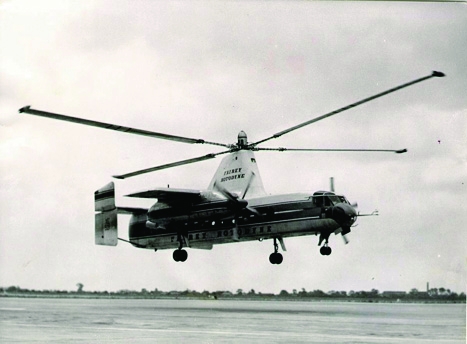
A helicopter at take-off and an autogyro during forward flight, the Fairey Rotodyne was, reported The Engineer, an exciting development for both commercial and military aviation markets.
With more than 90 flights already under its belt, the article reported that the aircraft had already exceeded its manufacturer’s expectations. ’The Fairey company states that hovering and vertical climb performance of the aircraft have already exceeded predictions. It has lifted slightly more than its designed all-up weight of 33,000lb, achieved a vertical rate of climb 1,300ft per minute and a forward climb of 2,400ft per minute. In the autogyro condition speeds exceeding 150mph have already been achieved. Design cruising speed of the rotodyne is 185mph.’
The Rotodyne featured a tip-jet-powered rotor that burned a mixture of fuel and compressed air bled from two wing-mounted Napier Eland turboprops. The rotor was driven for vertical take-offs, landings and hovering, and low-speed translational flight, and autorotated during cruise flight with all engine power applied to two propellers. The article drew particular attention to a noisesuppression nozzle on the tip jets, which it claimed ’were expected to reduce the present high noise levels to entirely acceptable values for commercial operation in built-up areas’.
Commenting on a rigorous testing programme that involved the attachment of hundreds of strain gauges to the rotor and airframe, The Engineer suggested that preflight testing of the rotodyne was perhaps the most exhaustive ever given a British aircraft. ’Development of a rotodyne with an upweight of about 70,000lb, a rotor diameter of 120ft and capable of carrying 200 passengers would appear to be feasible.’
Sadly, despite the success of the trials, the Rotodyne programme was cancelled due to a lack of commercial interest and government cuts in 1959. The so-called ’gyrodyne’ concept has, however, been revisited in recent years with Groen Brothers Aviation one of several companies keen to develop the technology further.




Swiss geoengineering start-up targets methane removal
No mention whatsoever about the effect of increased methane levels/iron chloride in the ocean on the pH and chemical properties of the ocean - are we...